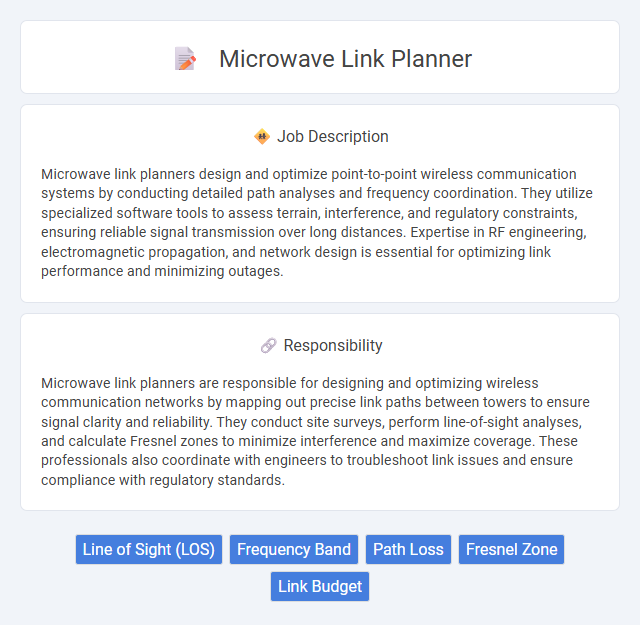
Microwave link planners design and optimize point-to-point wireless communication systems by conducting detailed path analyses and frequency coordination. They utilize specialized software tools to assess terrain, interference, and regulatory constraints, ensuring reliable signal transmission over long distances. Expertise in RF engineering, electromagnetic propagation, and network design is essential for optimizing link performance and minimizing outages.
Individuals with strong analytical skills and attention to detail are likely suitable for a Microwave Link Planner role, as the job demands precise planning and technical expertise. Those who thrive in environments requiring problem-solving and communication with technical teams may find this position aligns well with their abilities. Candidates who prefer repetitive or less technical tasks might struggle with the complexity and evolving challenges presented by this role.
Qualification
A Microwave Link Planner must possess a strong background in telecommunications engineering, typically holding a degree in Electrical Engineering or a related field. Proficiency in RF propagation analysis, spectrum management, and the use of specialized software like Pathloss or iBwave is essential for designing efficient microwave communication links. Experience in site survey, link budget calculation, and compliance with regulatory standards significantly enhances the capability to ensure optimal network performance and reliability.
Responsibility
Microwave link planners are responsible for designing and optimizing wireless communication networks by mapping out precise link paths between towers to ensure signal clarity and reliability. They conduct site surveys, perform line-of-sight analyses, and calculate Fresnel zones to minimize interference and maximize coverage. These professionals also coordinate with engineers to troubleshoot link issues and ensure compliance with regulatory standards.
Benefit
Microwave link planner jobs likely offer significant career benefits such as developing expertise in wireless communication technologies and network infrastructure. Professionals in this role probably experience high demand due to the growth of telecommunication networks, potentially leading to job stability and competitive salaries. Furthermore, the position may provide opportunities for working on cutting-edge projects and collaborating with engineering teams to optimize network performance.
Challenge
Microwave link planner jobs likely involve overcoming complex challenges such as optimizing signal paths in densely populated or geographically difficult areas. They may need to address interference, weather impacts, and regulatory constraints while ensuring reliable connectivity. Problem-solving skills and precise technical knowledge probably play a crucial role in managing these obstacles effectively.
Career Advancement
Microwave link planner roles involve designing and optimizing wireless communication networks, crucial for telecom infrastructure development. Mastery of RF engineering, site surveys, and network simulation tools accelerates career progression toward senior technical or management positions. Continuous skill enhancement in emerging technologies like 5G and microwave backhaul expands opportunities for leadership roles in network planning and operations.
Key Terms
Line of Sight (LOS)
Microwave link planners specialize in designing and optimizing wireless communication systems by assessing Line of Sight (LOS) conditions to ensure clear signal paths between transmission points. They use advanced GIS and propagation modeling software to analyze terrain, obstacles, and Fresnel zones, minimizing signal loss and interference. Accurate LOS evaluation is critical for establishing reliable microwave links in telecommunications, broadcasting, and network infrastructure projects.
Frequency Band
Microwave link planner roles demand expertise in selecting optimal frequency bands, such as the 6 GHz, 11 GHz, and 18 GHz ranges, to ensure minimal interference and maximum signal clarity. Proficiency in analyzing regulatory constraints and spectrum allocation within licensed and unlicensed bands enhances link reliability and network efficiency. Understanding atmospheric attenuation effects on C-band and Ku-band frequencies further optimizes link performance in varying environmental conditions.
Path Loss
Microwave link planners analyze and optimize path loss to ensure reliable point-to-point wireless communication. They calculate signal attenuation caused by distance, atmospheric conditions, and obstacles, using tools like the ITU-R P.525 model to design efficient microwave links. Accurate path loss estimation is critical for selecting appropriate antenna types, power levels, and frequencies to maintain signal integrity over the link.
Fresnel Zone
A Microwave Link Planner specializes in designing communication links by analyzing and optimizing the Fresnel Zone to ensure minimal signal obstruction and maximize signal strength. Understanding the Fresnel Zone's elliptical area between transmitting and receiving antennas is critical for preventing interference caused by physical obstacles, which reduces signal attenuation and improves link reliability. Precise calculation and clearance of the Fresnel Zone play a vital role in achieving high-quality microwave communication networks in urban and remote environments.
Link Budget
A Microwave Link Planner specializes in calculating Link Budget to ensure reliable wireless communication between two points. This process involves analyzing parameters such as transmitter power, antenna gain, path loss, and atmospheric conditions to optimize signal strength and quality. Accurate Link Budget calculations minimize signal degradation and maximize the efficiency of microwave link deployments in telecommunication networks.
 kuljobs.com
kuljobs.com